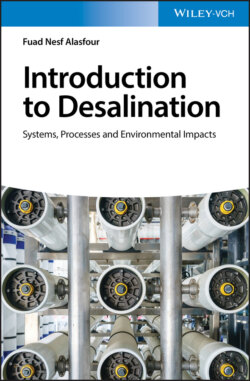Читать книгу Introduction to Desalination - Fuad Nesf Alasfour - Страница 10
Preface
ОглавлениеThe aim of writing Introduction to Desalination textbook is to provide the academic sector with an educational, state‐of‐the‐art desalination teaching book.
The textbook is prepared to be a source of knowledge in the field of desalination and to provide solutions to freshwater capacity need in the world, and it aims to enhance both teaching and learning aspects in engineering educational field.
A comprehensive theoretical foundation for several industrial applications in the field of desalination is presented in a friendly and challenging way, covering basic principles of desalination processes: thermal and membrane system using conventional and renewable energy type, in addition to real engineering examples.
The content tends to integrate the basics of engineering science disciplines under the umbrella of desalination systems, namely, thermodynamics (energy and exergy), fluid mechanics, heat and mass transfer, water chemistry, environmental, and economic, in addition to sustainability aspect.
The textbook includes 10 chapters with materials that are mostly required in university engineering curriculum courses; it aims to develop intuitive understanding of the basics and practices in industrial desalination field. The objectives of teaching desalination course are:
1 Train and teach student how to model a desalination system, and then analyze, design, and select the proper desalination system in the light of 4E's (energy, exergy, environment, and economic aspects).
2 Examine desalination system under different operating conditions and design parameters using sensitivity analysis (parametric study).
3 Assess and evaluate different conventional and hybrid desalination configurations using conventional and renewable types of energy.
4 Train student to select one research paper (per topic) from a referred journal for reproduction in the light of 4E's.
The textbook is recommended for senior undergraduate and graduate engineering students during a one‐semester course (14 weeks). Student must have knowledge and background in the following fields: thermodynamics, fluid mechanics, and heat mass transfer as a prerequisite.
There are several sections, examples, and problems that can be considered as advanced types, which are suitable for graduate level course.
On the other side, parts of the textbook can be used by practicing engineers in the field of desalination plant industry. Student needs to download the following software in order to solve examples:
1 ROSA
2 Nitto
3 Engineering Equation Solver (EES)
The textbook's suggested plan in a one‐semester‐course is shown in the following Table 1.
Table 1 Suggested desalination course plan (14 weeks).
| Chapter | Topics | Number of weeks | Number of hours (1 wk = 3 h) |
| 1 | Introduction | 1 | 3 |
| 2 | MEE | 1.33 | 4 |
| 3 | MSF | 1.33 | 4 |
| 4 | VC | 1 | 3 |
| 5 | MF, UF, NF, and RO | 2 | 6 |
| 6 | ED and EDR | 1 | 3 |
| 7 | MD | 1 | 3 |
| 8 | FO, PV, and dialysis | 1 | 3 |
| 9 | Renewable energy | 1.33 | 4 |
| 10 | Hybrid system | 1 | 3 |
| Σ = 12 | +2 wk for quizzes, exams, and project presentation |
At the end, special thanks to my students whom I learned from and to engineer Alfadel Taqi for his valuable contribution in software computational calculations. I wish that the textbook will be useful and helpful for both students and faculty members, whom I ask them kindly to contact me in case of any suggestions.
Kuwait
2020
Prof. Fuad Nesf Alasfour (fuadnalasfour@gmail.com)
